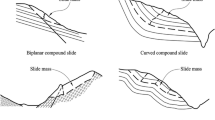Conclusion
-
1.
For blocks (slabs) with a smooth surface laid flush with the bottom, under the effect of a high-velocity flow with a uniform motion on them, the mean uplift is equal to zero.
-
2.
Under the effect of a fluctuating load, the block rises to a small height, which leads to a substantial increase of the mean dislodging load, primarily due to an increase of pressure on the bottom of the block.
-
3.
In the case of rock bed, when the sizes of the projections of the natural roughness are an order of magnitude and more greater than the height of uplift of the separate elements under the effect of the fluctuating load, the effect of the latter on dislodging a separate element is felt primarily on rupturing the bonds between adjacent blocks, and the main role in dislodging the separate elements is played by the mean uplift.
Similar content being viewed by others
Literature cited
G. L. Rubinshtein, “Laboratory investigations of the fracture of rocks in the lower pools of high overflow dams,” in: Transactions of Joint Conferences on Hydraulic Engineering [in Russian], VNIIG im. B. E. Vedeneeva, No. 7 (1963).
G. A. Yuditskii, “Force effect of the nappe on separate elements of a rock foundation and conditions of its failure,” Izv. VNIIG im. B. E. Vedeneeva,72, (1973).
V. V. Bukhanov, “Dynamic interaction of revetment slabs of the lower pool with the subslab region,” Izv. im. B. E. Vedeneeva,105 (1974).
Sh. N. Gagashidze, “Calculation of the excess hydrodynamic uplift in a fractured rock foundations having a block structure,” in: Hydrotechnical Construction and Problems of Power Engineering in Mountains [in Russian], Énergoizdat, Moscow (1981).
S. M. Mishchenko, “Force effect of a flow on the bottom of a stilling basin,” Izv. VNIIG im. B. E. Vedeneeva,208 (1988).
Yu. G. Zharykov, “Hydrodynamic effect of a nappe on separate elements of a rock bed,” in: Collection of Scientific Papers, Izv. VNIIG im. B. E. Vedeneeva,162 (1982).
Yu. G. Zharkov, “Mechanisms of fracture of a rock bed by a nappe,” in: Collection of Scientific Papers, Izv. VNIIG im. B. E. Vedeneeva,179 (1985).
Yu. G. Zharkov, “Failure of fractured block masses under the effect of mean and fluctuating loads,” in: Collection of Scientific Papers, Izv. VNIIG im. B. E. Vedeneeva,208 (1988).
Additional information
Translated from Gidrotekhnicheskoe Stroitel'stvo, No. 4, pp. 37–41, April, 1990.
Rights and permissions
About this article
Cite this article
Zharkov, Y.G. Mechanism of failure of fractured block masses under the effect of a high-velocity flow. Hydrotechnical Construction 24, 270–276 (1990). https://doi.org/10.1007/BF01428213
Issue Date:
DOI: https://doi.org/10.1007/BF01428213




